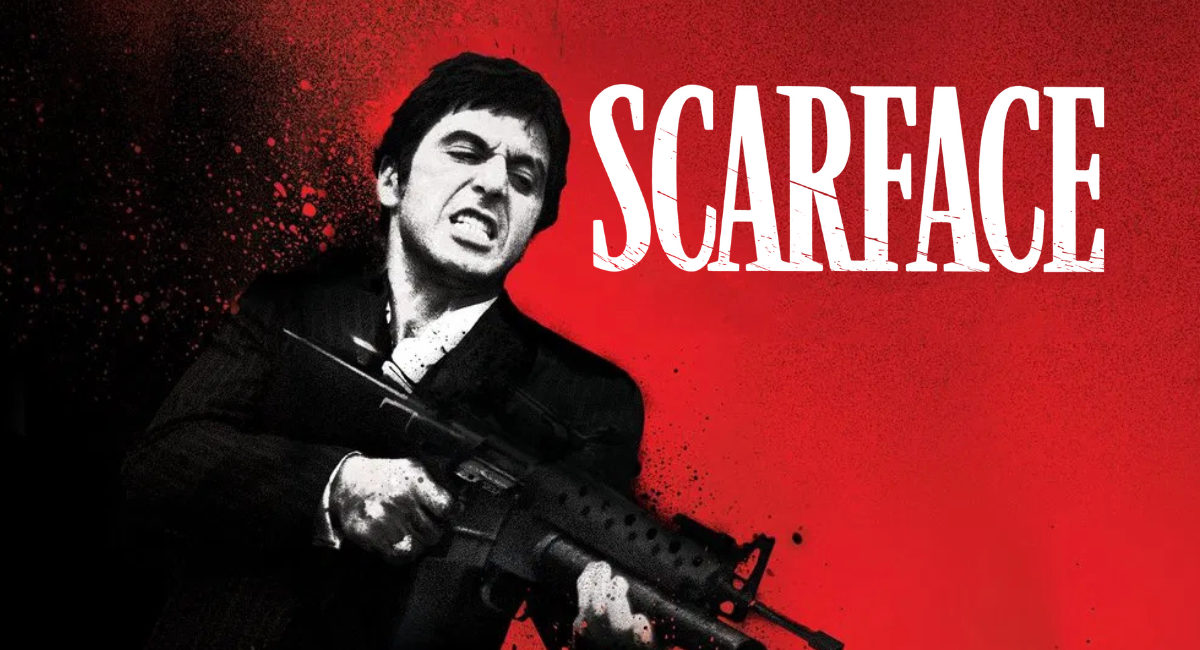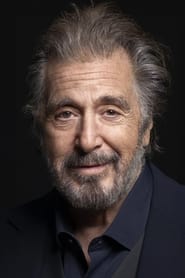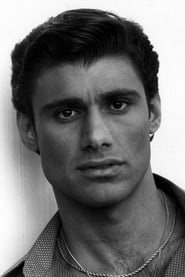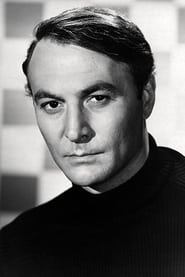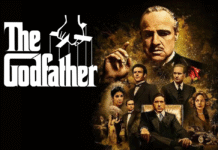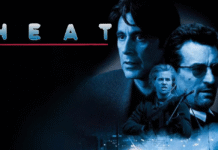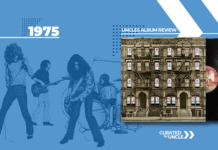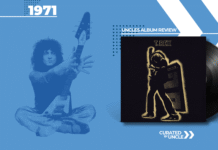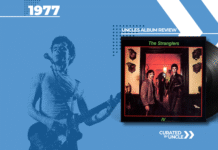Say Hello to My Little Review: Revisiting Scarface (1983)
If Scarface were a person, it would snort a line off your grandmother’s coffee table, insult your haircut, shoot up the kitchen and then blame you for it. Released in 1983 to the sound of collective moral panic, Brian De Palma’s Scarface has gone from critically mauled to culturally canonised – like a cocaine-fuelled phoenix rising from a pile of VHS tapes and regret.
With Al Pacino turning in a performance so loud it probably caused earthquakes in neighbouring films, Scarface is many things: a cautionary tale, a satire of the American Dream and a fashion crime scene. It’s also a film that asks the vital question: how many times can one man say “fuck” before it becomes a sort of performance art? Scarface is a well deserved entry in to our ranking list The 50 Greatest Gangster Movies of All Time
Let’s descend into the gold-plated, bullet-riddled, coke-smeared underworld of Scarface a film that redefined excess long before MTV Cribs got involved.
Table of Contents
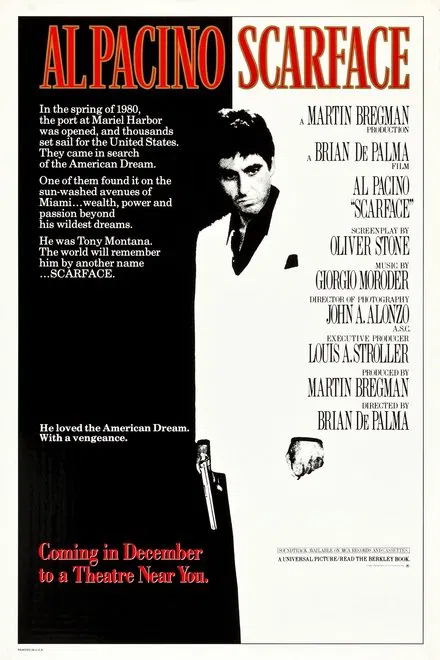
The Plot: Rise, Snort, Repeat
Set in 1980s Miami, Scarface tells the story of Tony Montana, a Cuban refugee with more ambition than tact. After arriving during the Mariel boatlift, Tony works his way up from dishwasher to drug kingpin in roughly the same amount of time it takes most people to find parking in Miami.
His ascent is swift, brutal and drenched in enough machismo to make a UFC weigh-in look like a tea party. Tony doesn’t just want money, he wants the world. And thanks to a healthy disregard for laws, human life and personal safety, he nearly gets it – until, of course, the whole house of cocaine collapses like a nosebleed at a rave.
Along the way, he offs his best friend, alienates everyone who ever loved him and builds a mansion that looks like Liberace had a stroke in a gold mine. It’s the classic rags-to-riches-to-bullet-riddled-body-in-a-fountain arc, with a mountain of nose candy and a pile of corpses just to keep things lively.
Performances: A Masterclass in Madness
Let’s give credit where it’s due: the cast does a phenomenal job of keeping up with the insanity.
- Al Pacino is utterly unhinged and utterly magnetic. It’s a performance of pure, distilled mania.
- Michelle Pfeiffer (as Elvira Hancock) plays the ultimate ‘80s ice queen dead-eyed, razor-sharp and visibly bored of every man in the room. She’s not a character so much as a mood.
- Steven Bauer as Manny is Tony’s best friend and human shield. He’s charming, loyal and doomed. Basically a Disney sidekick in a Tarantino movie.
- Robert Loggia brings gravitas as Frank Lopez, a man who learns the hard way that giving Tony Montana a job is like giving a chimpanzee a hand grenade.
Tony Montana: The American Dream With a Body Count
Al Pacino’s portrayal of Tony Montana is what happens when subtlety goes on holiday and never comes back. With a Cuban accent that sounds like it was learned from a haunted cassette tape and facial expressions that range from “constipated fury” to “murderous rage,” Pacino turns Tony into a walking, shouting metaphor for unrestrained capitalism.
Tony is ruthless, paranoid and incapable of whispering. He’s also disturbingly charismatic. You hate him. You love him. You want him to stop talking. Then you want to quote him for the rest of your life. He’s a one-man meme factory, decades before memes existed.
It’s not just that Tony wants the world – he thinks he deserves it. Which, in the 1980s, was the sexiest kind of delusion you could have. His catchphrase, “The world is yours,” should’ve been embroidered on every yuppie’s cocaine napkin.
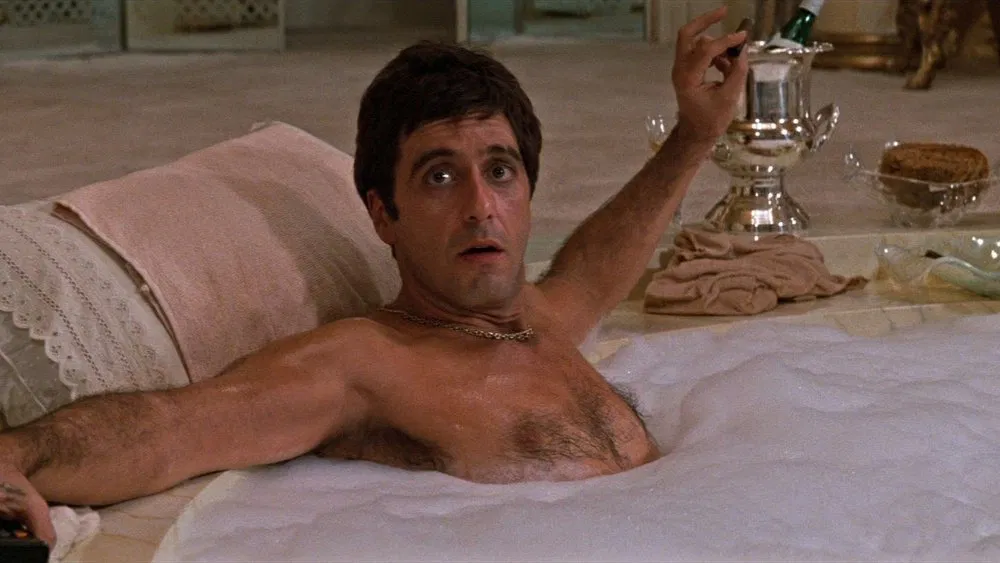
Direction & Screenplay: Brian De Palma and Oliver Stone Get Weird
De Palma directs Scarface like he’s had three espressos and a minor stroke. The camera swoops, lingers and occasionally glares at you like a disappointed father. It’s bold, it’s brash and it’s utterly De Palma.
The screenplay, courtesy of a young and furious Oliver Stone, drips with nihilism. Stone wrote it while battling a cocaine addiction, which might explain why the film’s idea of a “quiet moment” is a chainsaw execution in a shower.
The dialogue is iconic and often ridiculous. Half the script sounds like it was written in capital letters. Tony doesn’t talk; he declares war on vowels. Still, for all its excess, there’s an undeniable rhythm to the madness. Scarface doesn’t care if you think it’s too loud- it wants to be.
Quickfire Fun Facts About Scarface (Because SEO Demands It)
- The word “fuck” is used 226 times. That’s roughly once every 29 seconds.
- The infamous chainsaw scene was inspired by a real-life cartel execution Oliver Stone read about while researching.
- Al Pacino burned his hand during the final shootout by accidentally grabbing a hot barrel.
- The film was originally rated X by the MPAA. De Palma refused to recut it, so they eventually caved and gave it an R.
- Martin Scorsese allegedly warned De Palma after a screening: “You guys are great – but be ready, because they’re going to hate it.”
Violence, Cocaine and Interior Design: The Holy Trinity of 80s Cinema
Let’s talk about the violence, because frankly, so does the film. Scarface isn’t just violent; it’s cartoonishly violent. From the infamous chainsaw scene – where Tony watches his mate get dismembered in a motel shower like it’s a TED Talk on dismemberment – to the climactic final shootout where Tony absorbs bullets like they’re compliments, this film doesn’t pull punches. It throws them at your face in slow motion.
And the cocaine. My God, the cocaine. This film could’ve been sponsored by Columbia’s GDP. Mountains of it. Lines so thick they cast shadows. It’s not a plot device – it’s practically a character. Possibly the only one Tony truly loves.
Then there’s the décor. Tony’s mansion is what happens when someone tries to recreate Versailles after bingeing on Scarab beetles and Scarborough Fair. Golden statues, marble staircases and a hot tub the size of a small country. It’s Liberace meets Grand Theft Auto – if Grand Theft Auto did interior design.
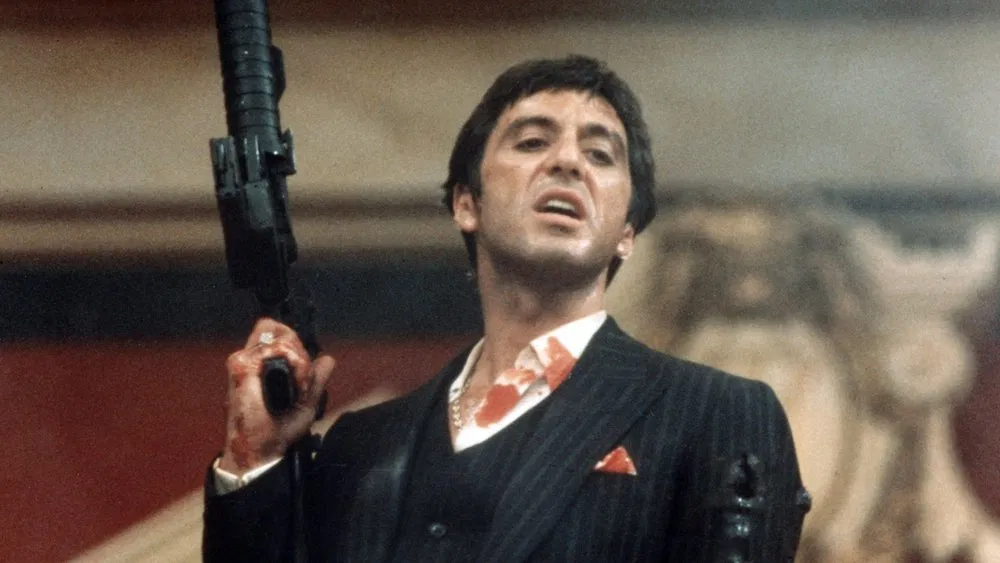
Critics Then vs. Critics Now: The Great U-Turn
When Scarface first hit cinemas, critics recoiled like it had coughed blood on their monocles. It was slammed for being vulgar, excessive and morally bankrupt – which, fair enough, it absolutely is. Roger Ebert was one of the few to get it, calling it “brilliantly directed and acted.” Others labelled it a glorified snuff film.
Fast forward a few decades and Scarface has been absorbed into pop culture like a bullet into Tony’s chest. It’s quoted by rappers, parodied by sitcoms and studied by film students who’ve clearly never held down a minimum wage job. It’s gone from cautionary tale to inspirational poster for financial nihilists.
Themes: The American Dream, But With More Ammo
Underneath all the shouting and sniffing, Scarface is a grotesque funhouse mirror held up to the American Dream. Tony Montana is the ultimate self-made man – immigrant, entrepreneur, psychopath. He doesn’t inherit his fortune; he kills for it.
His story is capitalism without brakes, soul, or basic PR training. Tony accumulates wealth and power at a breakneck pace, but he can’t stop. Because to stop is to admit he was never in control to begin with. He doesn’t fall from grace – he dives headfirst into it with a grenade launcher.
And that’s the joke. Scarface is a satire, not an endorsement. The tragedy is that so many people, especially in hip-hop culture, took Tony Montana as a role model instead of a massive red flag with a machine gun.
Legacy: How a Psychopath Became a Pop Culture Icon
Tony Montana is now more merch than man. His face is plastered on posters, T-shirts, mugs and god knows what else. He’s a brand. Which is ironic, considering he spent most of the movie spiralling into coke-addled madness.
You can’t walk into a student dorm or a “man cave” without seeing that shot of him with a gun, yelling “Say hello to my little friend!” as if that’s a normal thing to say while redecorating someone’s torso with bullets.
It’s a film that somehow became both a warning and a fantasy. A tragedy and a mood board. It’s the cinematic equivalent of someone winning the lottery, buying a tank and then driving it straight into a swimming pool.
My Final Thoughts: Why Scarface Still Slaps (and Shoots and Screams)
Scarface is not a perfect film. It’s long, it’s loud and it occasionally disappears up its own mirrored staircase. But it is unforgettable. It’s a cinematic Molotov cocktail hurled at the myth of the self-made man, dressed in a velvet suit and high on his own supply.
Its influence is undeniable. Its impact, cultural and otherwise, is still being felt. It’s the movie that proved you can fail upward, so long as you do it with enough bullets, bravado and sheer psychotic determination.
Like Tony himself, Scarface is flawed, chaotic and impossible to ignore. It’s less a film and more a cocaine-dusted fever dream of Reagan-era excess. And somehow, all these years later, it still feels relevant. Which probably says more about society than it does about cinema.
So, if you haven’t watched it recently – or ever – do yourself a favour. Turn down the lights, turn up the volume and prepare for one of the most gloriously tasteless masterpieces ever made.
Just maybe don’t watch it with your mum.

If You Like Scarface, I Recommend These Movies:
Carlito’s Way (1993) – like Scarface, but with less cocaine and more regret
The Untouchables (1987) – A film where Kevin Costner’s moral compass is so straight it could serve as a ruler
Casino (1995) – Scorsese’s three-hour cautionary tale about why you should never mix business with pleasure
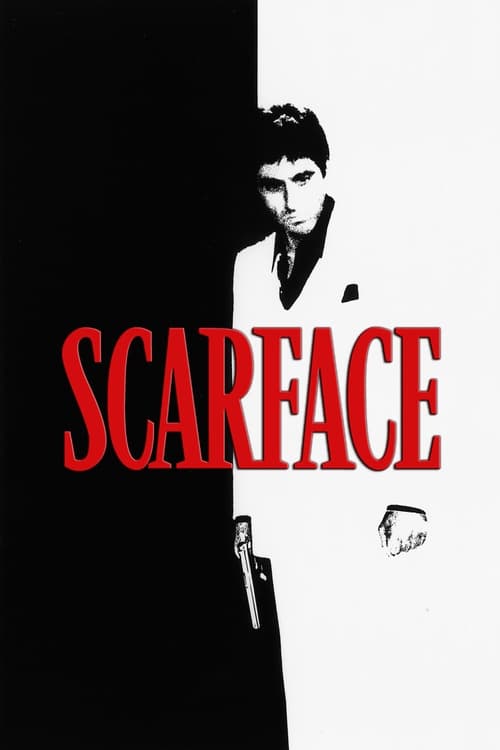
Scarface
Tony Montana
Manny Ray
Elvira
Gina
Frank Lopez
Mama Montana
Omar
Alejandro Sosa



